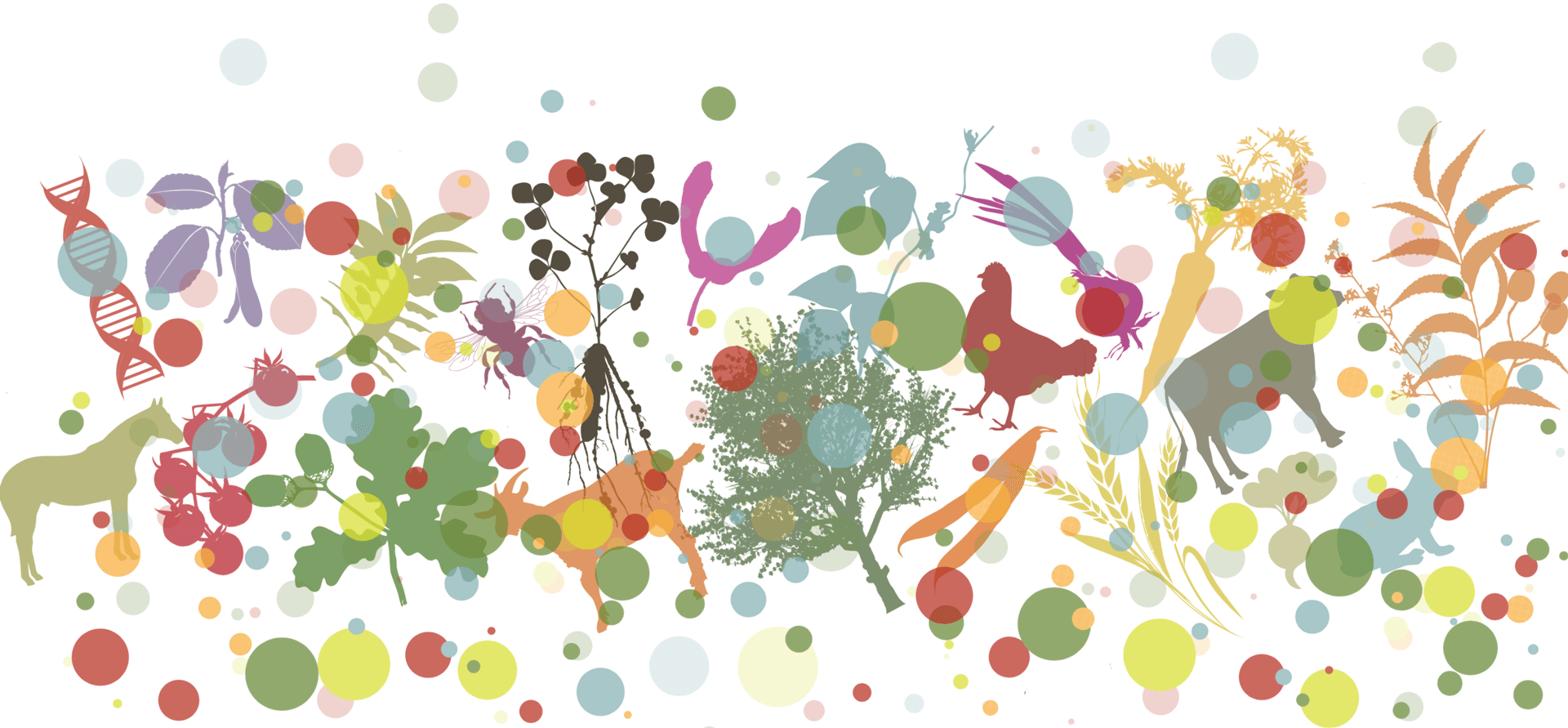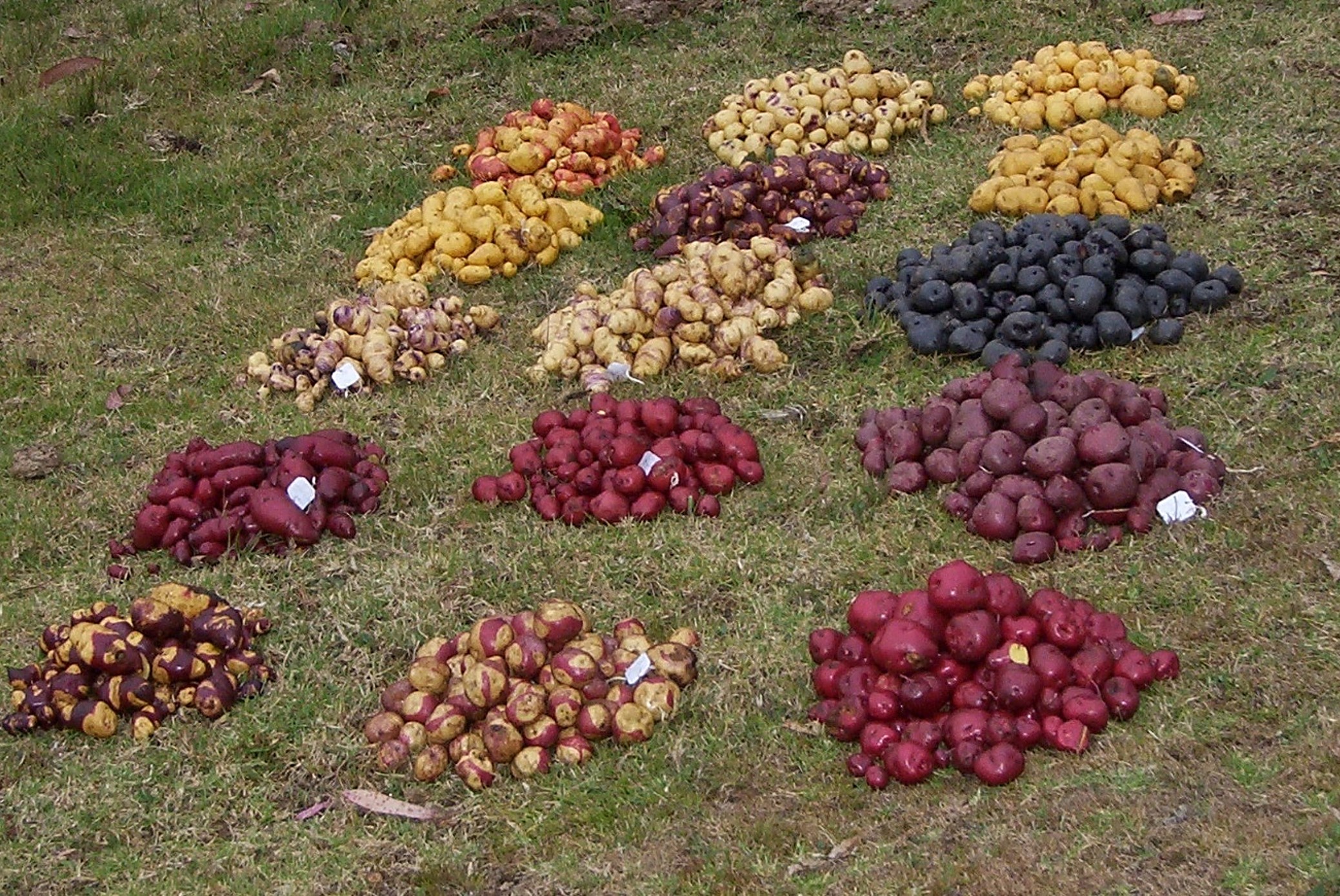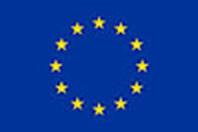Cultivar loss and conservation of genetic resources of the phureja potato (Solanum phureja L., Phureja Group) in Peru
Main Article Content
Abstract
Solanum tuberosum L. Phureja Group, known in Peru as ‘phureja potato’ or ‘chaucha potato’ and as ‘criolla’ in Colombia, is characterized by its earliness and the absence of dormancy in the tubers. It stands out for its nutritional value and its contribution to food security. However, it faces a high risk of disappearance in Peru. This study assessed its current status by collecting historical data, ex situ and in situ conservation analyses, and genetic erosion studies in local communities. Historical information suggests that phureja was relevant and abundant in the past. Currently, ex situ collections include 69 accessions, of which the International Potato Center conserves a significant portion. As for in situ conservation, 116 accessions have been identified. However, since 1992, genetic erosion has been documented in six departments of Peru. The main causes include: lack of time for continuous cultivation, prioritization of dairy farming, low seed quality, preference for more commercial modern or traditional cultivars, and the expansion of mining projects. The critical situation of the phureja potato requires urgent measures to collect new information and evaluate the remaining genetic variability. This assessment is essential to develop conservation and sustainability strategies to ensure its survival and its contribution to Peru's food and cultural well-being.
Article Details

This work is licensed under a Creative Commons Attribution 4.0 International License.
Authors retain copyright of the articles published in Genetic Resources and grant the journal right of first publication with open access. All articles published in Genetic Resource are licensed under Creative Commons Attribution 4.0 International License (CC BY 4.0) that allows others to download, share and adapt the work for commercial and non-commercial purposes as long as proper attribution to the original article is given. Genetic Resources permits and encourages authors to post items submitted to the journal (including the publisher's final layout) on personal websites or institutional repositories after acceptance and/or publication, while providing bibliographic details that credit their publication in Genetic Resources.
Asociación-Pataz, CIP, INIA and AGUAPAN (2023). Catálogo de variedades de papa nativa de Tayabamba, La Libertad, Perú.
Beltrán-Penagos, M A, A P Sánchez-Camargo, and C E Narváez-Cuenca (2020). “Proximal composition, bioactive compounds and biorefinery approach in potato tubers of Solanum tuberosum Group Phureja: a review”. International Journal of Food Science and Technology 55(6), pp. 2282–2295. DOI: https://doi.org/10.1111/ijfs.14461. DOI: https://doi.org/10.1111/ijfs.14461
Brush, S B, H J Carney, and Z Humán (1981). “Dynamics of Andean potato agriculture”. Economic Botany 35(1), pp. 70–88. DOI: https://doi.org/10.1007/BF02859217. DOI: https://doi.org/10.1007/BF02859217
Burgos, G et al. (2020). “The potato and its contribution to the human diet and health”. In: The potato crop. Its agricultural, nutritional and social contribution to humankind. Ed. by H. Campos and O. Ortiz. doi: https://link.springer.com/book/10.1007/978-3-030-28683-5, pp. 37–74. Cabrera, H and R Pando (2011). Catálogo de variedades mejoradas y nativas de papa en la Región de Cajamarca. Estación Experimental Baños del Inca, Instituto Nacional de Investigación e Innovación Agraria. Vol. 75. Martínez Compañón, p. 75. DOI: https://doi.org/10.1007/978-3-030-28683-5_2
Canahua, A et al. (2002). “Gestión del espacio agrícola y agro diversidad en papa y quinua en comunidades campesinas de Puno”. In: SEPIA IX. Ed. by M. Pulgar-Vidal, E. Zegarra, and J. Urrutia.
Cerón-Lasso, M et al. (2018). “Composición fisicoquímica y propiedades antioxidantes de genotipos nativos de papa criolla (Solanum tuberosum GrupoPhureja)”. Informacion Tecnologica 29(3), pp. 205–216. DOI: https://doi.org/10.4067/S0718-07642018000300205. DOI: https://doi.org/10.4067/S0718-07642018000300205
CIP (2023). CIP Genebank. URL: https://genebank.cipotato.org/gringlobal/search.aspx. CIP and FEDECH (2006). Catálogo de variedades de papa nativa de Huancavelica. Centro Internacional de la Papa; Federación Departamental de Comunidades Campesinas de Huancavelica. Metrocolor. URL: https://hdl.handle.net/10568/101328.
CIP, Asociación Pataz., and INIA (2015). Catálogo de variedades de papa nativa de Chugay, La Libertad, Perú. Centro Internacional de la Papa.
CIP, Grupo Yanapai, Gobierno Regional de Huancavelica and AGUAPAN (2021). “Catálogo Línea de Base de la Diversidad de Papa Nativa del Microcentro Yauli - Paucará, Huancavelica, Perú”. In: Lima, Perú: Centro Internacional de la Papa (CIP), p. 300.
Cosio, P (2006). Variabilidad de papas nativas en seis comunidades de Calca y Urubamba, Cusco. Cusco, Perú: Asociacion Arariwa.
Dawson, T et al. (2023). “Identifying priority sites for the on-farm conservation of landraces and systematic diversity monitoring through an integrated multi-level hotspot analysis: the case of potatoes in Peru”. Frontiers in Conservation Science 4. DOI: https://doi.org/10.3389/fcosc.2023.1130138. DOI: https://doi.org/10.3389/fcosc.2023.1130138
De Carvalho, M A et al. (2016). “Agrobiodiversity: The importance of inventories in the assessment of crop diversity and its time and spatial changes”. In: Genetic diversity and erosion in plants, sustainable development and biodiversity. Ed. by M. R. Ahuja and S. M. Jain. Vol. 8. doi: https://doi.org/10.1007/978-3-319-25954-3_9. Springer. DOI: https://doi.org/10.1007/978-3-319-25954-3_9
De Haan, S, J Núñez, et al. (2010). “Multilevel agrobiodiversity and conservation of Andean potatoes in Central Peru: Species, morphological, genetic, and spatial diversity”. Mountain Research and Development 30(3), pp. 222–231. DOI: https://doi.org/10.1659/MRD-JOURNAL-D-10-00020.1. DOI: https://doi.org/10.1659/MRD-JOURNAL-D-10-00020.1
De Haan, S and G Thiele (2004). “In situ conservation and potato seed systems in the Andes”. In: Seed systems and crop genetic diversity on-farm. Ed. by D. I. Jarvis et al. . IPGRI (International Plant Genetic Resources Institute.
Derteano, C (1944). “Informe sobre el cultivo y costo de producción de papa”. Revista Nacional de Agricultura 9(39).
Devaux, A et al. (2020). “). Global Food Security, Contributions from Sustainable Potato DOI: https://doi.org/10.1007/978-3-030-28683-5_1
Agri-Food Systems”. In: The potato crops. Its agricultural, nutritional and social contribution to humankind. Ed. by H. Campos and O. Ortiz. Vol. 1. doi: https://doi.org/10.1007/978-3-0 30-28683-5, pp. 3–34.
Egúsquiza, R (2015). Catálogo de papas nativas cultivadas en Huánuco. Universidad Nacional Agraria La Molina.
Ellis, D et al. (2020). “Ex situ conservation of potato [Solanum Section Petota (Solanaceae)] genetic resources in genebanks”. In: The potato crop. Its agricultural, nutritional and social contribution to humankind. Ed. by H. Campos and O. Ortiz. Vol. 4. doi: https://doi.org/10.1 007/978-3-030-28683-5, pp. 109–138. DOI: https://doi.org/10.1007/978-3-030-28683-5_4
Fonseca, C et al. (2014). Catálogo de variedades de papa nativa con potencial para la seguridad alimentaria y nutricional de Apurímac y Huancavelica. Lima: Centro Internacional de la Papa.
Forbes, G A et al. (2020). “The seed potato”. In: The potato crop. Its agricultural, nutritional and social contribution to humankind. Ed. by H. Campos and O. Ortiz. Vol. 12. doi: https://link.s pringer.com/book/10.1007/978-3-030-28683-5, pp. 431–447. DOI: https://doi.org/10.1007/978-3-030-28683-5_12
Fu, Y B (2017). “The vulnerability of plant genetic resources conserved ex situ”. Crop Science 57(5), pp. 2314–2328. DOI: https://doi.org/10.2135/cropsci2017.01.0014. DOI: https://doi.org/10.2135/cropsci2017.01.0014
Gabriel, J and J Franco (2013). “Solanum phureja Juz et Buk.: Valuable Source of Genetic Resistance to Potato Late Blight [Phytophthora infestans (Mont.) de Bary]”. Revista Latinoamericana de la Papa 17(2), pp. 131–142.
GPC (2014). Concesiones mineras en el Perú. Análisis y Propuestas de Política.
Gutiérrez, R and C Valencia (2010). “Las papas nativas de Canchis. Un catálogo de biodiversidad. Intermediate Technology Development Group (ITDG)”. In: Lima, Perú: Servicios Gráficos JMD.
Hancco, J, R Blas, and M Quispe (2008). Pampacorral: catálogo de sus papas nativas. Universidad Nacional Agraria La Molina.
Herrera, F (1921). Flora del departamento del Cuzco. Primera parte. 2nd ed. Universidad del Cuzco.
Huamán, Z and D M Spooner (2002). “Reclassification of landrace populations of cultivated potatoes (Solanum sect. Petota)”. American Journal of Botany 89(6), pp. 947–965. DOI: https://doi.org/10.3732/ajb.89.6.947. DOI: https://doi.org/10.3732/ajb.89.6.947
Iberico, L (1981). El Folklore Agrario de Cajamarca. Universidad Nacional de Cajamarca. INCAP Jorge Basadre (n.d.). Características del germoplasma nativo de Chota. Cajamarca, Perú, p. 27.
INDECOPI (2023). Estudio de mercado sobre el sector lácteo en el Perú. Informe final. Lima, Perú: Instituto Nacional de Defensa de la Competencia y de la Protección de la Propiedad Intelectual.
Joshi, B K et al. (2020). Good practices for agrobiodiversity management. Kathmandu, Nepal: NAGRC, LI-BIRD and Bioversity International.
Khoury, C K et al. (2022). “Crop genetic erosion: understanding and responding to loss of crop diversity”. New Phytologist 233(1), pp. 84–118. DOI: https://doi.org/10.1111/nph.17733. DOI: https://doi.org/10.1111/nph.17733
Lasso, Z et al. (2018). Dry matter and specific gravity content evaluation in the Central Colombian Collection Solanum tuberosum Group Andigena. World Potato Congress. Cusco, Perú.
Leiva, S, M Gonzalo, and R Saenz (1990). Medicina del campo. Departamento de Acción Social del Obispado de Cajamarca. Área de salud-medicina natural.
Lüttringhaus, S et al. (2021). “Dynamic guardianship of potato landraces by Andean communities and the genebank of the International Potato Center”. CABI Agriculture and Bioscience 2(1). DOI: https://doi.org/10.1186/s43170-021-00065-4. DOI: https://doi.org/10.1186/s43170-021-00065-4
Martinet, J B (1977). La Agricultura en el Perú. Reimpreso del original de 1877. Centro Peruano de Historia Económica, Universidad Nacional Mayor de San Marcos.
MINAGRI, Grupo Yanapai, INIA and CIP (2017). Catálogo de variedades de papa nativa del sureste del departamento de Junín - Perú. DOI: https://doi.org/10.4160/9789290602088. DOI: https://doi.org/10.4160/9789290602088
Muñoz, C and W Estaña (2012). Diversidad y variabilidad de papa nativa en Puno. Dirección Regional Agraria Puno. Lima, Perú.
Nagel, M et al. (2022). Global strategy for the conservation of potato. Global Crop Diversity Trust. DOI: https://doi.org/10.5447/ipk/2022/29.
Ñústez, C E (2021). “Papa chaucha (Solanum phureja)”. In: Los Andes y los alimentos del futuro. 50 Andean future foods. Ed. by S de Haan, M Zeigler, and F Guzmán, p. 157.
Ñústez, C E and L E Rodríguez (2020). Papa criolla (Solanum tuberosum Grupo Phureja. S. B. Universidad Nacional de Colombia.
Ochoa, C (1999). Las papas de Sudamérica. Perú. Lima, Perú: Centro Internacional de la Papa.
Ochoa, C M (1964). “Recuentos cromosómicos y determinación sistemática de papas nativas cultivadas en el Sur del Perú”. Anales Científicos. Perú 2(1).
Ochoa, C M (2001). Las papas de Sudamérica. Bolivia. Lima, Perú: Centro Internacional de la Papa.
Ochoa, C M (2003). Las papas del Perú. Base de datos 1947-1997. Gabriela Alcántara.
Padulosi, S and E Dulloo (2012). “Towards a viable system for monitoring agrobiodiversity on-farm: A proposed new approach for Red Listing of cultivated plant species”. In: On farm conservation of neglected and underutilized species: trends and novel approaches to cope with climate change. Proceedings of an International Conference held in Frankfurt, Germany, 14-16 June 2011. Ed. by S. Padulosi, N. Bergamini, and T. Lawrence. url: https://hdl.handle.net/1 0568/42046. Bioversity International, pp. 171–187.
Peña, C et al. (2021). “Variation of mineral contents with nutritional interest in a collection of Solanum tuberosum group Phureja tubers”. International Journal of Food Science and Technology 56(9), pp. 4594–4603. DOI: https://doi.org/10.1111/ijfs.15115. DOI: https://doi.org/10.1111/ijfs.15115
Plasencia, F et al. (2018). “Evaluación de la distribución espacial de la biodiversidad de papa en los distritos de Challabamba en Cusco y Quilcas en Junín mediante el uso del mapeo participativo”. Rev. del Instituto de Investigación de La Facultad de Ingeniería Geológica, Minera, Metalúrgica y Geográfica 21(41). DOI: https://doi.org/10.15381/iigeo.v21i41.14987
Priyanka, V et al. (2021). “Germplasm conservation: Instrumental in agricultural biodiversity-A review”. Sustainability 13(6743). DOI: https://doi.org/10.3390/su13126743. DOI: https://doi.org/10.3390/su13126743
PRODERIN (2018). La papa nativa en Apurímac. Identificación participativa de variedades en los distritos de Huayana y Pomacocha. Lima, Perú: Programa de desarrollo económico sostenible y de gestión estratégica de los recursos naturales en las regiones de Ayacucho, Apurímac, Huancavelica, Junín y Pasco.
Programa Bioandes (n.d.). Variedades de papas nativas y conocimientos campesinos. Microcuenca Shitamalca, San Marcos, Cajamarca. Cajamarca, Perú, pp. 20–20.
Rana, R B et al. (2006). “Four-cell analysis as a decision-making tool for conservation of agrobiodiversity on-farm”. In: On-farm management of agricultural biodiversity in Nepal: Good practices. Ed. by B.R. Sthapit, P Shrestha, and M Upadhyay. url: https://hdl.handle.ne t/10568/104917. Nepal: NARC/LI-BIRD/Bioversity International.
Revilla, L (2014). Costumbres de las papas nativas. Cusco, Perú: Centro de Servicios Agropecuarios, p. 187.
Río, A Del and J Bamberg (2021). “An AFLP marker core subset for the cultivated potato species Solanum phureja (Solanum tuberosum L. subsp. andigenum)”. American Journal of Potato Research 98, pp. 493–499. DOI: https://doi.org/DOI:10.1007/s12230-021-09849-w. DOI: https://doi.org/10.1007/s12230-021-09849-w
Riveros, C and J Peralta (2015). Catálogo de 12 cultivares de papa nativa inscritas en el Registro de Cultivares Comerciales. Huancayo, Perú: FOVIDA (Fomento de la Vida).
Rodríguez, L (2010). “Origen y evolución de la papa cultivada. Una revisión”. Agronomía Colombiana 28(1), pp. 9–17.
Roldan, A, L Palomino, and A R Salas (2019). Catálogo de variedades de papa nativa de las regiones de Apurímac, Cusco y Puno. Lima, Perú: Ministerio de Agricultura y Riego.
Seminario, J, H Tapia, and A Seminario (2019). Los Solanum del Grupo Phureja de Cajamarca. Avances. Gráfica Bracamonte Heredia.
Seminario, J and L Zarpán (2011). “Conservación in situ on farm-ex situ de Solanum tuberosum L. grupo Phureja en la cuenca del Llaucano y áreas adyacentes”. Arnaldoa 18(2), pp. 103–114.
Sierra, A et al. (2020). “Detección molecular de seis virus de ARN en brotes de tubérculos de papa criolla (Solanum phureja) en Antioquia, Colombia”. Bioagro 32(2), pp. 3–14.
Soukup, J (1970). Vocabulario de los nombres vulgares de la flora peruana. Colegio Salesiano. Thormann, I and J M M Engels (2015). “Genetic Diversity and Erosion—A Global Perspective”. In: Genetic Diversity and Erosion in Plants. Sustainable Development and Biodiversity. Ed. by M Ahuja and S Jain. Vol. 7. Cham: Springer. DOI: https://doi.org/10.1007/978-3-319-25637-5_10. DOI: https://doi.org/10.1007/978-3-319-25637-5_10
Varcárcel, L E (1985). Historia del Perú antiguo a través de la fuente escrita. 5th ed. Librería Editorial Juan Mejía Baca.
Vargas, C (1936). “El Solanum tubersoum a través del desenvolvimiento de las actividades humanas”. Revista Universitaria 25(70), pp. 138–223.
Vargas, C (1946). Las papas sudperuanas. Parte I. Universidad Nacional del Cuzco.
Vargas, C (1955). “Las papas sudperuanas. Parte II”. Revista Universitaria 44(108), pp. 175–240. Watanabe, L K, M Baigorria, and O Olcese (2008). Contribuciones al estudio de la papa en el Perú. San Marcos: San Marcos.
Wildlife Conservation Society (2022). Catálogo de variedades de papa nativa de la zona de agrobiodiversidad Andenes de Cuyocuyo. Press Off Graphics E.I.R.L.
Winters, P, L Hintze, and O Ortiz (2006). “Rural development and the diversity of potatoes on farms in Cajamarca, Peru”. In: Valuing Crop Biodiversity: On-Farm Genetic Resources and Economic Change. Ed. by M Smale, p. 161. DOI: https://doi.org/10.1079/9780851990835.0146
Wouw, M van de et al. (2009). “Genetic erosion in crops: Concept, research results and challenges”. Plant Genetic Resources: Characterization and Utilization 8(1), pp. 1–15. DOI: https://doi.org/10.1017/S1479262109990062. DOI: https://doi.org/10.1017/S1479262109990062
Yabar-Villagarcía, A A (2004). El manicomio azul. Cusco, Perú: Paucartambo, p. 109. Yanacocha (2018). Reporte de Sostenibilidad. Yanacocha.
Zimmerer, K S (1991). “Labor shortages and crop diversity in the Southern Peruvian Sierra”. Geographical Review 81(4), pp. 414–432. DOI: https://doi.org/10.2307/215608. DOI: https://doi.org/10.2307/215608
Zimmerer, K S (1992). “The loss and maintenance of native crops in mountain agriculture”. GeoJournal 27(1), pp. 61–72. DOI: https://doi.org/10.1007/BF00150635. DOI: https://doi.org/10.1007/BF00150635







 This journal has been conceived as part of the
This journal has been conceived as part of the